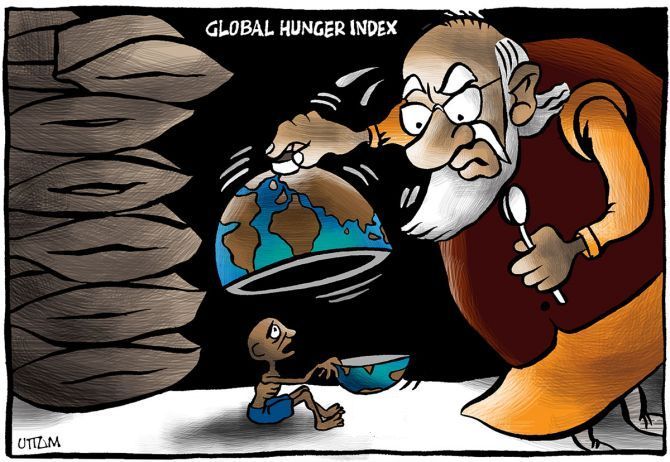India ranked 111th out of 125 countries in the Global Hunger Index-2023, which was rejected by the government as erroneous and having malafide intent.

The index, released on Thursday, also stated that India has the highest child wasting rate in the world at 18.7 per cent, reflecting acute undernutrition.
India ranked 107th out of 121 countries in the 2022 edition of the Global Hunger Index (GHI), a tool for comprehensively measuring and tracking hunger at global, regional, and national levels.
With a score of 28.7 in the Global Hunger Index-2023, India has a level of hunger that is serious, according to a report based on the index.
India's neighbouring countries Pakistan (102nd), Bangladesh (81st), Nepal (69th) and Sri Lanka (60th) have fared better than it in the index.
South Asia and Africa South of the Sahara are the world regions with the highest hunger levels, with a GHI score of 27 each, indicating serious hunger.
"India has the highest child wasting rate in the world, at 18.7 per cent, reflecting acute undernutrition," the report based on the index stated.
Wasting is measured based on children's weight relative to their height.
According to the index, the rate of undernourishment in India stood at 16.6 per cent and under-five mortality at 3.1 per cent.
The report also said that the prevalence of anaemia in women aged between 15 and 24 years stood at 58.1 per cent.
The government, however, rejected the index calling it a flawed measure of "hunger" that does not reflect India's true position.
The Women and Child Development Ministry said the index suffers from "serious methodological issues and shows a malafide intent".
"The index is an erroneous measure of hunger and suffers from serious methodological issues.
"Three out of the four indicators used for calculation of the index are related to the health of children and cannot be representative of the entire population.
"The fourth and most important indicator 'Proportion of Undernourished (PoU) population' is based on an opinion poll conducted on a very small sample size of 3,000," it said.
The ministry said that since April 2023, the measurement data of children under five years uploaded on the Poshan Tracker has consistently increased - from 6.34 crore in April 2023 to 7.24 crore in September 2023.
"The percentage of child wasting, as seen on the Poshan Tracker, has been consistently below 7.2 per cent, month-on-month, as compared to the value of 18.7 per cent used for child wasting in the Global Hunger Index 2023," the ministry said in a statement.
The ministry further said two other indicators, namely stunting and wasting, are outcomes of complex interactions of various other factors like sanitation, genetics, environment and utilisation of food intake apart from hunger which is taken as the causative/outcome factor for stunting and wasting in the GHI.
Also, there is hardly any evidence that the fourth indicator -- child mortality -- is an outcome of hunger, it said.
According to the index, the rate of undernourishment in India stood at 16.6 per cent and under-five mortality at 3.1 per cent.
The ministry further said two other indicators, namely stunting and wasting, are outcomes of complex interactions of various other factors like sanitation, genetics, environment and utilisation of food intake apart from hunger which is taken as the causative/outcome factor for stunting and wasting in the GHI.
The 2023 Global Hunger Index (GHI) shows that, after many years of advancement up to 2015, progress against hunger worldwide remains largely at a standstill.
The 2023 GHI score for the world is 18.3, considered moderate and less than one point below the world's 2015 GHI score of 19.1.
Furthermore, since 2017 the prevalence of undernourishment, one of the indicators used in the calculation of GHI scores, has been on the rise, and the number of undernourished people has climbed from 572 million to about 735 million, the index said.
The GHI said the compounding impacts of climate change, conflicts, economic shocks, the global pandemic, and the Russia-Ukraine war have exacerbated social and economic inequalities and slowed or reversed previous progress in reducing hunger in many countries.











 © 2025
© 2025